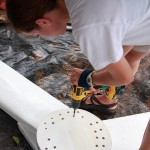US President Barack Obama’s belief that wind power and other renewable energy sources can help cure America of its addiction to expensive, polluting, imported oil has been translated into a $200-million stimulus grant that will help further expand a Washington State wind farm.
The cash grant is from the Department of Treasury through the American Recovery and Reimbursement Act. It will allow California-based Cannon Power Group to begin a third phase of its Windy Point/Windy Flats project in rural Klickitat County in southeast Washington.
“This grant constitutes a significant recognition of the increasingly important role renewable energy development has for our country — not only in terms of producing clean, safe and domestic energy for our citizens, but the enormous economic impact and jobs it provides for our local communities,” a Cannon press release quoted Washington State Governor Christine Gregoire saying last week.
“I applaud President Obama for his vision and leadership, and I am proud that the state of Washington is home to a project that is helping spur billions of dollars in private ‘green’ investment and creating thousands of jobs,” Gregoire added.
Gary Hardke, Cannon’s president and managing director, also commended Obama for making renewable energy development in the US a priority. “As an American-based company,” said Hardke, “we are up to the challenge.”
The company says it has already spent in the past 18 months close to $1 billion on the existing 400 megawatt project along the Columbia River. Cannon says that upon completion, the 500-MW wind farm near the Oregon border is expected to create electricity for about 250,000 homes and displace each year more than 800 metric tonnes of carbon dioxide. It has been said that it will become one of the largest wind energy facilities in the nation.
The expansion will add over 250 new jobs, providing $32 million in community benefits to the local area over the life of the project, Cannon says, adding this is in addition to the more than 350 jobs and $145 million in overall economic benefits created by the 400 MW the company has already installed.
Cannon says it already has at least 3,000 MW of wind projects in Europe and western North America.







 Comments
Comments


